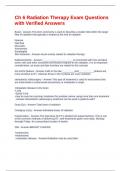Exam (elaborations)
Ch 6 Radiation Therapy Exam Questions with Verified Answers
- Course
- Institution
Boost - Answer-This term commonly is used to describe a smaller field within the larger filed of radiation that typically is treated at the end of radiation Nausea Diarrhea Mucositis Xerostomia Esophagitis Skin Reaction - Answer-Acute toxicity related to radiation therapy Radiosensitivit...
[Show more]




